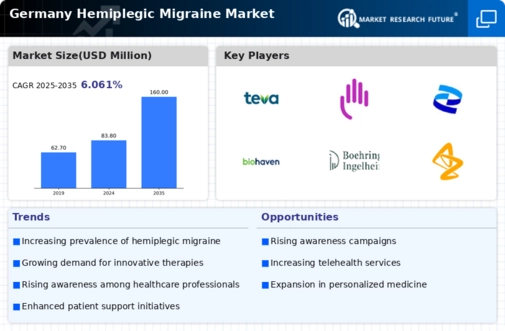Enhanced Research Funding
In Germany, the allocation of research funding for neurological disorders, including hemiplegic migraine, is on the rise. Government initiatives and private sector investments are increasingly directed towards understanding the underlying mechanisms of this condition. This influx of funding is expected to foster innovation in treatment methodologies and diagnostic tools, thereby propelling the hemiplegic migraine market forward. With more resources dedicated to research, the potential for breakthroughs in therapies and preventive measures increases, which may ultimately improve patient outcomes and expand market opportunities.
Growing Patient Advocacy Groups
The emergence of patient advocacy groups in Germany is playing a crucial role in raising awareness about hemiplegic migraine. These organizations are actively engaging in educational campaigns, which may lead to improved diagnosis and treatment options. As these groups gain traction, they are likely to influence healthcare policies and funding allocations, thereby impacting the hemiplegic migraine market positively. The increased visibility of hemiplegic migraine could result in a higher demand for specialized treatments, ultimately driving market growth as more patients seek assistance and support.
Technological Advancements in Diagnostics
Recent advancements in diagnostic technologies are transforming the landscape of the hemiplegic migraine market. In Germany, the integration of advanced imaging techniques and genetic testing is enhancing the accuracy of diagnoses. This progress is likely to lead to earlier identification of hemiplegic migraine cases, which could facilitate timely intervention and treatment. As diagnostic capabilities improve, the hemiplegic migraine market may experience growth, as healthcare providers are better equipped to manage and treat this complex condition effectively.
Increasing Prevalence of Hemiplegic Migraine
The rising incidence of hemiplegic migraine in Germany appears to be a significant driver for the hemiplegic migraine market. Recent studies indicate that approximately 0.1% of the population may be affected by this rare form of migraine, leading to an increased demand for effective treatment options. As awareness grows, healthcare providers are more likely to recognize and diagnose this condition, which could potentially lead to a surge in market growth. The hemiplegic migraine market is likely to benefit from this trend, as more patients seek specialized care and treatment solutions tailored to their unique needs.
Increased Collaboration Among Healthcare Providers
The trend of enhanced collaboration among healthcare providers in Germany is emerging as a key driver for the hemiplegic migraine market. Multidisciplinary approaches involving neurologists, pain specialists, and primary care physicians are becoming more common. This collaborative model may lead to improved patient management and treatment outcomes, as diverse expertise is pooled to address the complexities of hemiplegic migraine. Consequently, the hemiplegic migraine market could see growth as healthcare systems adapt to provide comprehensive care tailored to individual patient needs.

















Leave a Comment